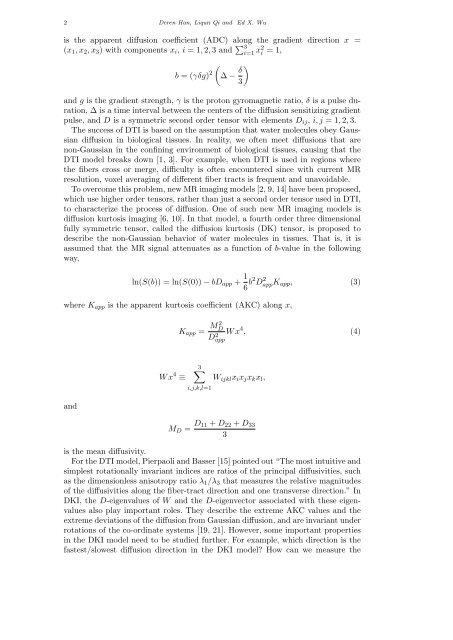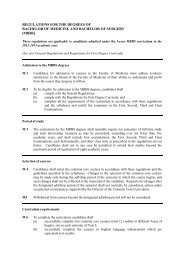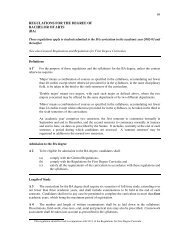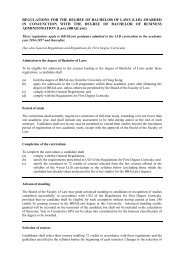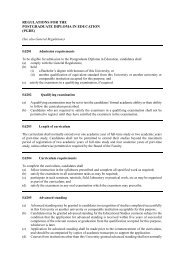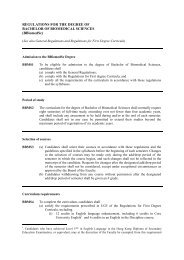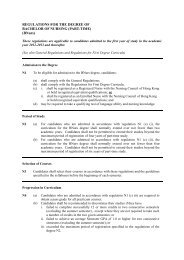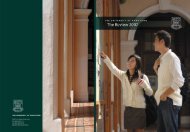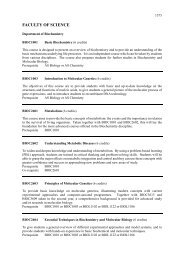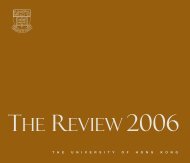RESEARCH ARTICLE Extreme Diffusion Values for non-Gaussian ...
RESEARCH ARTICLE Extreme Diffusion Values for non-Gaussian ...
RESEARCH ARTICLE Extreme Diffusion Values for non-Gaussian ...
You also want an ePaper? Increase the reach of your titles
YUMPU automatically turns print PDFs into web optimized ePapers that Google loves.
2 Deren Han, Liqun Qi and Ed X. Wu<br />
is the apparent diffusion coefficient (ADC) along the gradient direction x =<br />
(x 1 , x 2 , x 3 ) with components x i , i = 1, 2, 3 and ∑ 3<br />
i=1 x2 i = 1,<br />
(<br />
b = (γδg) 2 ∆ − δ )<br />
3<br />
and g is the gradient strength, γ is the proton gyromagnetic ratio, δ is a pulse duration,<br />
∆ is a time interval between the centers of the diffusion sensitizing gradient<br />
pulse, and D is a symmetric second order tensor with elements D ij , i, j = 1, 2, 3.<br />
The success of DTI is based on the assumption that water molecules obey <strong>Gaussian</strong><br />
diffusion in biological tissues. In reality, we often meet diffusions that are<br />
<strong>non</strong>-<strong>Gaussian</strong> in the confining environment of biological tissues, causing that the<br />
DTI model breaks down [1, 3]. For example, when DTI is used in regions where<br />
the fibers cross or merge, difficulty is often encountered since with current MR<br />
resolution, voxel averaging of different fiber tracts is frequent and unavoidable.<br />
To overcome this problem, new MR imaging models [2, 9, 14] have been proposed,<br />
which use higher order tensors, rather than just a second order tensor used in DTI,<br />
to characterize the process of diffusion. One of such new MR imaging models is<br />
diffusion kurtosis imaging [6, 10]. In that model, a fourth order three dimensional<br />
fully symmetric tensor, called the diffusion kurtosis (DK) tensor, is proposed to<br />
describe the <strong>non</strong>-<strong>Gaussian</strong> behavior of water molecules in tissues. That is, it is<br />
assumed that the MR signal attenuates as a function of b-value in the following<br />
way,<br />
ln(S(b)) = ln(S(0)) − bD app + 1 6 b2 D 2 appK app , (3)<br />
where K app is the apparent kurtosis coefficient (AKC) along x,<br />
K app = M D<br />
2<br />
Dapp<br />
2 W x 4 , (4)<br />
and<br />
3∑<br />
W x 4 ≡ W ijkl x i x j x k x l ,<br />
i,j,k,l=1<br />
M D = D 11 + D 22 + D 33<br />
3<br />
is the mean diffusivity.<br />
For the DTI model, Pierpaoli and Basser [15] pointed out “The most intuitive and<br />
simplest rotationally invariant indices are ratios of the principal diffusivities, such<br />
as the dimensionless anisotropy ratio λ 1 /λ 3 that measures the relative magnitudes<br />
of the diffusivities along the fiber-tract direction and one transverse direction.” In<br />
DKI, the D-eigenvalues of W and the D-eigenvector associated with these eigenvalues<br />
also play important roles. They describe the extreme AKC values and the<br />
extreme deviations of the diffusion from <strong>Gaussian</strong> diffusion, and are invariant under<br />
rotations of the co-ordinate systems [19, 21]. However, some important properties<br />
in the DKI model need to be studied further. For example, which direction is the<br />
fastest/slowest diffusion direction in the DKI model How can we measure the


